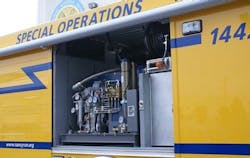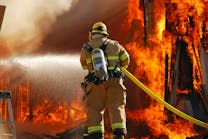Choosing On-Board Apparatus Equipment Wisely Takes Research
Apparatus get more complex each year as fire departments and responders try to put more and more on their rigs to get stuff done. Some of the most expensive equipment on apparatus are things like extrication tool systems and breathing air recharging units. While they are largely bolt-on items, careful thought has to be put into the selection process balancing needs with budgets.
To help untangle some of that process, Firehouse talked to a few manufacturers of apparatus-based extrication tool systems and SCBA refilling stations, including Holmatro, for some info on the extrication side, and Scott Safety and Bauer Compressor on the breathing air side.
Safety first
Marv Carroll is the product manager for Scott Safety’s air compressor division. Carroll said one of the most important things firefighters need to consider when specifying apparatus-mounted breathing air systems is to make sure they are 100 percent safe. Compressed air is dangerous if a cylinder blows up. There’s enough force to physically damage the structure of the apparatus, he said.
“You have to be able to vent systems and vent them away from the person so if it goes off, the blast goes away from the person,” Carroll said.
Carroll said there have been cases were fire departments have made investments in good charging stations and mounted them solid with sometimes catastrophic results.
To help make a decision on whether to purchase a filling station with a compressor system or go with a cascade system, which is made up of refillable DOT or new high-strength NF gas cylinders, usually four, Carroll offers some advice. Departments need to look at the capacity of their SCBA bottles and match that with the number of cylinders that might be used at any scene.
“If you have 2.2 cylinders, you can fill those all day long with a cascade system, but if you go up to the 4.5 or 5.5 cylinders, you may have to consider a compress on site,” Carroll said. “You should consider whether you have to fill them on site or if you have a compressor somewhere else.
He said there is always a balance with demand, need and the budget, adding that the cylinder-based system is always the cheapest.
When a decision is made to move up to the compressor system, Carroll said, departments should consider the fact they’ll need 2,000-watts of power for every compressor horse power. Many breathing air compressors for filling stations are 12 to 13 horsepower, which means a generator would have to be 24,000-watts at minimum to run the compressor. Carroll said a generator of that size can cost upward of $28,000.
“That’s a hard sell on a $300,000 truck or even a $450,000 truck,” Carroll said, noting the expenditure can be more easily absorbed on a “super truck” in the $900,000 and up range.
Carroll said another option is to create a filling station on a trailer that is pulled by a pickup truck, something he said most departments have readily available in their fleets.
Scott Safety makes a diesel-powered, direct drive compressor system for filling stations. They’re powered by 46-hp engines and incorporate 7.2Kw generators, sufficient to run lights and some rehab equipment and rechargeable battery-operated equipment, Carroll said, adding that the price tag for that kind of unit is about $150,000.
“A little air trailer can make a good option over a truck,” he said.
NFPA certification is key
Bauer Compressor, a maker of breathing air equipment, is based in Norfolk, VA. Bill Dickson is the company’s vice president of sales for the breathing air products division.
Dickson’s immediate advice to fire departments seeking apparatus-based filling stations and compressors is to refer to National Fire Protection Association’s (NFPA) 1901 for guidance.
“1901 is going to be your guide,” Dickson said, noting that it will be important for the chosen manufacturers to provide certificates that they’ve compiled with the standards.
As Carroll from Scott said, Dickson notes that picking the right compressor is a function of calculating the “peak demand.”
“You’ll have to consider the size of the bottles, the number of bottles, the number of bottles you think you’ll use and you take all that to determine the peak demand.
In many cases, the compressor might end up being in the 20 to 30 horsepower range, Dickson said, adding that the small 6,000- to 7,000-watt generator is nowhere near sufficient to power it.
“Most [apparatus] builders are very good at sizing the generator to the compressor,” Dickson said. “Most times, it will be an air and light unit and they are very good matching the generator to the load of the truck.”
He said it’s also important to remember the height of the equipment on the apparatus. Mobile units, because of how they are mounted, are often taller than stationary units and consequently, departments must be mindful of things like controls, on/off switches and even the height of the filling stations themselves.
“You don’t want the vertical height so high the operator can’t use it,” Dickson said.
And, when it comes to controls, Dickson said there have been a lot of changes made in recent times, moving to electronic controls. He said the younger generation is very much into the tactic and automated controls. He added it is critically important to have the fill station be built to handle the size of the compressor.
“The fill station has to be take the full pressure the compressor is creating,” Dickson said. “It’s a relationship that should not be taken lightly or bodily harm and injury could occur.” He also said it’s important to get all the certificates required to ensure safety.
When selecting builders, Dickson said it’s important that the successful bidder be able to service not only the apparatus, but the equipment that’s on it. “They should be able to service both pieces,”
Dickson is also a big proponent of making sure the compressors are well vented, not only for blast relief, but also for compressor cooling. He said compressors are often mounted transverse over the rear wheels and need to have cross ventilation. While it might be attractive to use the space on the back of the compressor, the opposite end of the fill station, for storage, it should be avoided. It is possible to use the space for SCBA bottle storage because the voids between the bottles will still allow ample air circulation for the compressor.
Circling back to his original statement, Dickson said it is best for fire departments to rely on the NFPA standards when selecting compressors and filling stations. Vet the builders to make sure they are able to meet the standards and then get the documentation and the certification to back up the claims. It’s too important to ignore them, Dickson said.
Power up
While extrication tools and apparatus-mounted power supplies are significantly different than breathing air systems, they have similarities and also help firefighters meet the missions they desire.
Holmatro is an extrication tool maker with its United States headquarters in Glen Burnie, MD. Fran Dunigan is extrication tool product manager with the company has been part of the business for nearly 20 years. He says, when it comes to apparatus-based extrication tools and accessories, “the options are unlimited.”
With Holmatro’s system, he said the hoses don’t change from apparatus-based power units to the portable units. Even the tools themselves don’t change. Fire departments that want apparatus plumbed extrication power supplies, can take portable units and plug them into the apparatus and have the advantage of a tethered unit and a portable unit.
He said Holmatro has co-designed a hose reel system with Hannay to accept Holmatro’s CORE technology two-in-one hose, which is the overwhelming choice for all the company’s tools.
Holmatro also has worked with Harrison Hydra-Gen to develop a hydraulic pump to power the Holmatro pumps for on-board apparatus applications, Dunigan said.
“If fire departments are looking to save space, rather than having a huge 230-volt rescue tool pump, they can go with a hydraulically-driven pump,” Dunigan said. He said the hydraulic pump will also power a smaller generator off the same transmission PTO shaft.
“The Harrison unit is really an attractive system,” Dunigan said, noting that the cost savings and the weight savings are the biggest benefits. He added it has sufficient power to operate its Quattro four-tool extrication pump.
“It did it with power to spare,” Dunigan said. “It’s really slick.”
Dunigan said in addition to considering reels and power sources for apparatus-mounted extrication tool power supplies, fire departments should think about tethered connections. He said bulkhead fittings allow responders to flip up a lid and plug in the hose and go as all the plumbing to the power unit is built in the truck. Bulkhead fitting can be located wherever the responders designate, including the front bumper for quick access and convenience, he said.
Dunigan said Holmatro has systems for fire departments considering battery-powered tools. Holmatro has a hydraulic pump system that is powered by an electric motor and a battery. It uses the same hoses and the same tools, cutters and spreaders as the PTO or engine driven units.
Many battery-powered extrication tools have the batteries attached to the tools which makes underwater extrication and use impossible. But with Holmatro’s system, the power unit can stay high and dry while just the ordinary tool can be submerged.
“You can’t anticipate what situations you’ll be in, so it’s better to be prepared for everything,” Dunigan said.
The power units and the tools are the most important parts of the apparatus based systems, but Dunigan said departments need to have all that equipment mounted and ready to use. Truck mounted brackets for tools and power units are vitally important.
“You need to keep the tools fast and easy to deploy and stow,” he said.

Ed Ballam
Ed Ballam served as associate editor for Firehouse. He is the assistant chief of the Haverhill Corner, N.H. Fire Department, and a National Registered EMT. He is also a Deputy Forest Fire Warden for the New Hampshire Division of Forests and Lands. Professionally, he's been a journalist for over 35 years working for a variety of publications, including employment as managing editor of a national fire service trade journal for more than a decade.










